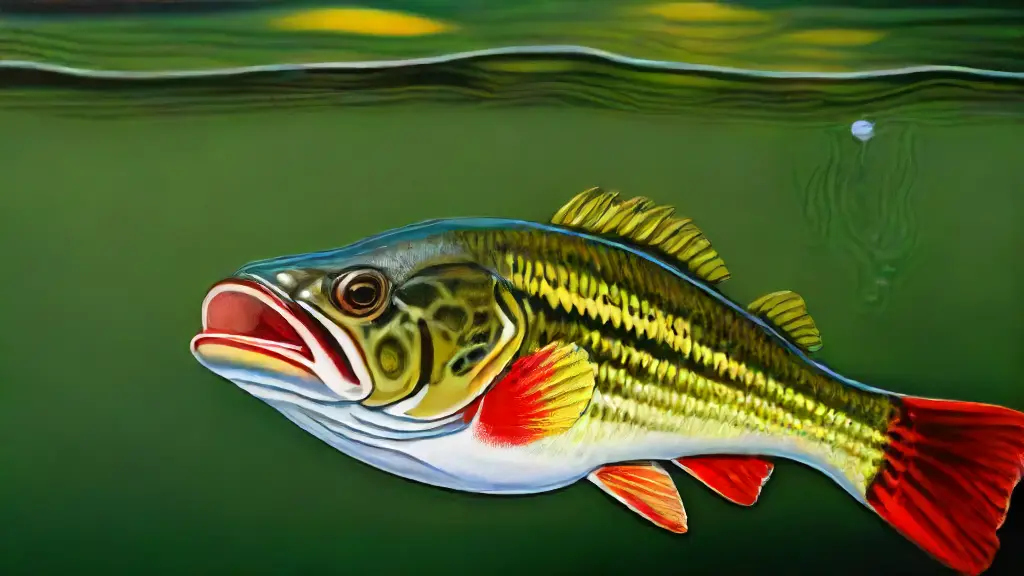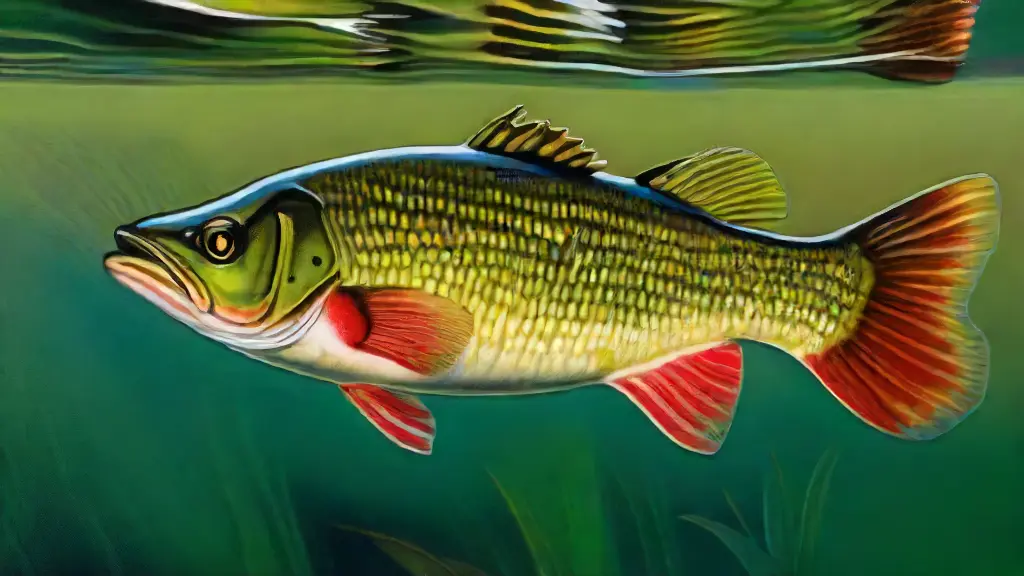How to Use Crankbaits for Smallmouth Bass in Fast Water

Exploring the fast-moving waters of a river or lake, anglers often find themselves face-to-face with the aggressive and elusive Smallmouth Bass. To successfully land one of these feisty fish, understanding the key factors that influence the effectiveness of crankbait presentations is crucial.
Identify ideal cranking depths and retrieve speeds for fast-moving water
Crankbait retrieval speeds and depths are crucial when targeting Smallmouth Bass in fast water.
Typically, slower retrieval speeds and shallower depths (2-4 feet) are effective in riverine environments with moderate velocity.
In areas with high flow, increasing retrieve speed and depth (4-6 feet) can increase the effectiveness. Utilize effective crankbait presentations for holding in riverine environments where smallmouth bass are likely to congregate in areas with fastwater, high velocity, and structural features like rocks, undercut banks, and overhangs where water flow is altered.
Riverine Hideaways for Smallmouth Bass
As water flows through the landscape, it carves out intimate spaces that smallmouth bass find irresistible, hiding in plain sight among the river’s subtle contours. Riverine hideaways, in fact, can be daunting for even the most experienced anglers, with their twists and turns, drop-offs, and hidden ledges.
To master the art of crankbait fishing, you need to develop a drift that lets you cover a lot of ground while also presenting your lure in a way that looks natural to the fish.
This natural presentation requires a delicate balance between retrieval and cadence, with the slightest pause or acceleration triggering a strike.
Here, the fish often lurk, anticipating the struggle of a snagged lure, their strike zone dictated by the subtlest changes in water flow. Adjusting your tackle and gear accordingly can make all the difference, ensuring a successful drift, drag, retrieval, and strike.

What is the Best Crankbait Selection
The art of enticing smallmouth bass requires a deep understanding of their instincts and the design of the tools used to tempt them. Crisp water conditions demand a crankbait that can withstand turbulent water and accurately mimic the movement of a paddling crawdad or an airborne insect.
Crankbait selection is often a crucial aspect of successful smallmouth bass fishing, and understanding the intricacies of this important factor can make a significant difference in your catch rate.
In fast water conditions, it’s essential to have a well-designed crankbait that can withstand the turbulent water and accurately mimic the movement of a baitfish, such as a crawdad or insect, to attract smallmouth bass. One of the key considerations when selecting a crankbait is the vibrations it produces, as this can help attract smallmouth bass by mimicking the scent and movement of their natural food sources, such as baitfish swimming through aquatic vegetation or insects and crustaceans that they would normally forage for.
| Crankbait Characteristics | Fast Water Conditions | Fast Water Movement | Vibrations |
|---|---|---|---|
| Turbulent Water Resistance | Essential | Paddling Crawdad or Airborne Insect | Mimic Natural Food Sources |
| Vibration Production | Key Consideration | Baitfish Swimming through Aquatic Vegetation | Attract Smallmouth Bass |
| Accurate Mimicry | Crucial Aspect | Insects and Crustaceans | Forage for Food |
How to Present Crankbaits in Fast Water
Exploring the intricacies of smallmouth bass behavior in fast water is crucial for a successful day on the lake, where subtle changes in approach can spell the difference between a mediocre catch and a record-breaking haul.
Crankbaits are a staple in many bass fishermen’s arsenal, but presenting them effectively in fast water requires a delicate balance of strategy and tactics.
Fast water, characterized by its swift currents and tumultuous surface, demands a unique approach to crankbait presentation.
A good starting point is understanding the key factors that influence smallmouth bass behavior in these environments.
Smallmouth bass are often drawn to the edges of fast water, where the current’s energy creates a sense of ambush and surprise. Stealthily presenting a crankbait that mimics the swimming motion of a baitfish can increase the chances of a strike. In these turbulent waters, shapes and sizes of crank Retrieve your prey through diving, swimming, ambush, surprise, stealth, strategy, and tactics.
Effective Retrieval Techniques for Smallmouth Bass
In the world of freshwater angling, few species are as revered as the smallmouth bass, with its reputation for being one of the most challenging and entertaining fish to catch.
Understanding the nuances of smallmouth bass behavior is crucial for effective retrieval techniques. One key aspect is the importance of identifying structure and cover in the microhabitat.
This can be achieved through the use of electronics and navigation, which provide valuable insights into the underwater environment.
Structure refers to natural or man-made features that provide refuge for smallmouth fish.
These can include navigation around drop-offs, mapping weed beds, and contouring rocky outcroppings.
By identifying structure and cover, anglers can target specific areas where smallmouth species are likely to congregate. such as fishfinders, electronics, navigation, mapping, contour, and depthfinder, allowing users to accurately detect and track schools of fish and specific species.
Smallmouth Bass
- Smallmouth bass are considered one of the most challenging and entertaining fish to catch.
- Understanding the nuances of smallmouth bass behavior is crucial for effective retrieval techniques.
- Electronics and navigation tools, such as fishfinders and depthfinders, can provide valuable insights into the underwater environment.
- Identifying structure and cover in the microhabitat is key to targeting specific areas where smallmouth species are likely to congregate.
How to Use Water Structure to Your Advantage
As the sun beats down on the gravel-strewn shore, the gentle lapping of the water against the bank creates a soothing melody that belies the intense energy lurking beneath the surface.
Water’s kinetic energy is a powerful force that can make or break a fishing trip, and understanding how to harness it can be the difference between a mediocre catch and a spectacular haul.
When it comes to fast water, smallmouth bass are particularly susceptible to the dynamics at play. This is because they have evolved to thrive in areas with high velocity and low water depth, where the sheer force of the water creates a unique habitat that’s teeming with food and shelter. In order to capitalize on this, anglers must first identify areas with high velocity and low water depth, and recognize the importance of underwater structure in creating a favorable habitat for predators to setlines.
Deception Tactics for Smallmouth Bass in Fast Flow
As the current swirls around the kayak, the smallmouth bass conceal themselves beneath the silt, poised to pounce. When pursuing these aggressive predators in fast-flowing water, it’s essential to understand the deception tactics they employ to evade detection.
One of the most effective ways to outsmart them is by imitating the natural food sources they feed on, such as crayfish and baitfish.
Smallmouth Bass
- Smallmouth bass are known for their aggressive behavior in fast-flowing water.
- Crayfish and baitfish are common food sources for smallmouth bass in their natural habitat.
- Smallmouth bass use deception tactics, such as hiding beneath silt, to evade detection by predators.
- Imitating natural food sources is an effective way to lure smallmouth bass into biting.
How to Choose the Right Baitfish Imitations
As the sun’s gentle rays dance across the water’s surface, a sense of tranquility washes over the angler. Tranquil waters often require a delicate touch, but what about the murky depths where the smallmouth bass lurk? Understanding the concept of baitfish imitations is crucial to successful smallmouth bass fishing.
The concept of baitfish imitations is a crucial aspect of smallmouth bass fishing.
These imitations are exaggerated versions of the baitfish that smallmouth bass prey upon in their natural habitat.
Factors to Consider When Choosing Baitfish Imitations
When selecting the right baitfish imitation, several factors come into play. Water clarity and visibility play a significant role, as clear waters often require more subtle presentations, whereas murky waters can accommodate more aggressive or boisterous imitations. Fish species and their behavior in fast water, current speed and water structure greatly affect the success of walking, submerging, and concealed fishing using fishing line.
What are the Key Factors in Crankbait Presentation for Smallmouth Bass
Smallmouth bass can be notoriously finicky, but a well-presented crankbait is often the secret to success in these waters. Water currents play a significant role in determining the retrieve speed and cadence of your crankbait presentation, making it essential to adapt your technique to the river’s flow.
Unlike still water, where a consistent retrieve speed can be effective, fast water requires a more dynamic approach.
The increased river speed demands a slower retrieve to give the crankbait time to react and create a more enticing presentation, while also allowing you to make subtle adjustments to your cadence and direction to imitate the natural movement of baitfish. A slower retrieve enables the crankbait to react to the river’s structure, whether it’s a series of rocks or an undercut bank, allowing you to create a more lifelike movement that subtly mimics the river’s water currents, water velocity, river currents, river flow, and river speed.
Best Crankbaits for Slow Retrieves
Best Crankbaits for Targeting Large Smallmouth Bass
Best Crankbaits for Targeting Large Smallmouth Bass

As anglers venture into the serene waters of freshwater lakes and rivers, the thrill of reeling in a trophy smallmouth bass is often the ultimate goal. To achieve this feat, a careful selection of crankbaits is crucial, as it can make all the difference between a tantalizing catch and a frustrating day on the water.
Local Knowledge for Successful Crankbaiting
Crankbaits designed to mimic injured baitfish are a staple in any smallmouth bass angler’s arsenal, as they capitalizing on the species’ natural instinct to feed on wounded prey. By immersing oneself in the world of smallmouth bass habitats, including structure like submerged rock formations and weed beds, one can unlock the secrets to choosing the best crankbait depths and presentations in freshwater reservoirs.
What Draws Smallmouth Bass In
The thrill of smallmouth bass fishing lies in its unpredictability, requiring anglers to carefully consider the intricacies of underwater structure, habitat, and food sources to increase their chances of reeling in a big catch.
For many anglers, the allure of smallmouth bass fishing is rooted in its challenges and rewards.
When it comes to attracting these feisty fish, one crucial factor is the tackle and gear used.
A masterful cast, employing the right line and lure, can be the difference between a missed strike and a hooked monster.
Structure and Habitat:
The underwater structure of a lake or river is a major draw for smallmouth bass. Rocky reefs, boulders, and weed beds provide the perfect hiding spots for these fish, making them difficult to detect. By targeting areas with these structures, anglers can increase their chances of catching a big game fish.

Crankbait Design Essentials for Success
Mastering the art of crankbait fishing requires a deep understanding of the subtle nuances in lure design, which can make all the difference in successfully reeling in a catch.
Understand the Role of Planing Surfaces and Lips in Crankbait Diving
Planing surfaces and lips play a crucial role in determining the diving depth and speed of a crankbait.
The design of these features can significantly impact the lure’s ability to dive and stay submerged, making it essential for fishermen to understand their functions.
| Retrieve Speed | Effectiveness | Water Condition |
|---|---|---|
| Slower | More Effective | Murky Water |
| Faster | More Effective for Understanding Fish Behavior | Clear Water |
| Mimicking Injured Baitfish or Small Crustaceans | Critical for Triggering Smallmouth Bass | All Water Conditions |
How to Choose the Right Lure for Smallmouth Bass
When it comes to luring smallmouth bass, technique is crucial, but the right lure is equally important. In fact, studies have shown that presenting the right lure can increase your chances of catching bass by up to 30%.
Understanding Smallmouth Bass Behavior
Water clarity plays a significant role in determining bass behavior.
In clear waters, bass tend to be more active and aggressive, while in murky waters, they become more sluggish and defensive.
Factors to Consider When Selecting a Lure
Lure size is directly related to water temperature, with larger lures tending to work better in warmer waters and smaller lures in cooler waters. Retrieval speed is also crucial, as a slow retrieve can elicit a reaction from bass in thick vegetation, where ridges and points provide perfect hiding spots. When choosing the right lure for your murky waters, consider the unique features of points, ridges, and ledges, as well as the bass feeding patterns, food chain, and presence of baitfish and forage species, and use the right type of cover and concealment, such as a weedless crankbait or skirted crankbait, to effectively fish heavy cover, thick vegetation, and other hard-to-reach areas.
Whats the Best Diving Crankbait for Murky Water
Fishermen often tout the importance of adapting to changing fishing conditions, but few acknowledge the equal significance of embracing the challenges that come with murky water. On that note, when the water is cloudy and unforgiving, the right crankbait can be a game-changer in luring those elusive fish.
The key to selecting the perfect crankbait for murky water lies in understanding the importance of bait selection factors.
Vibration and noise production, size and shape, and color and contrast all play a critical role in attracting fish.
For instance, crankbaits that produce high-pitched vibrations can be particularly effective in these conditions.
When it comes to constructing a crankbait for murky water, the materials and design play a crucial role.
Diving depth and water visibility are critical factors, as is lure weight and presentation. Boat positioning and anchoring require careful consideration of the rocky shoreline, sand bars, gravel banks, boat positioning, anchoring, casting distance, casting accuracy, line management, leader selection, lure presentation, water temperature, and fish activity to ensure effective fishing techniques.
Can You Use Squarebill Crankbaits in Weedy Areas
Presenting lures effectively in dense vegetation is a delicate art, requiring a deep understanding of the intricacies involved in lure presentation and retrieval. Fishing in weedy areas can be a daunting challenge, especially when it comes to angling tactics and selecting the right lure for the job.
Squarebill crankbaits have gained popularity in recent years due to their unique design and versatility, making them a favorite among bass fishing experts.
The squarebill shape and design of these lures allow them to navigate through thick vegetation with ease, thanks to their ability to deflect and deflecting water.
The weight distribution and buoyancy of the lure also play a crucial role in its effectiveness in weedy areas. Why Squarebill Crankbaits Excel in Weedy Areas
The squarebill’s unique shape and design make it particularly effective in dense vegetation, where a careful selection of lure color and pattern, as well as precise presentation, can lead to a high catch rate.
How to Select the Perfect Curly Tail Crankbait
When the sun beats down on a summer day, there’s no better feeling than setting the hook on a feisty smallmouth bass, and curly tail crankbaits are often the secret to success. Curly tail crankbaits are a favorite among smallmouth bass fishermen, offering a tantalizing attraction that can’t be replicated with other Storm Chasers.
When selecting the perfect curly tail crankbait, it’s essential to consider lure size, crankbait material, and crankbait construction to ensure the right presentation for the target species.
The Rebel curly tail crankbait, for example, features a unique tail design that mimics the movement of a small baitfish, making it irresistible to smallmouth bass. As you search for the perfect crankbait, consider the lure size, lure weight, crankbait material, crankbait construction, fishing line, fishing rod, fishing reel, and fishing tackle brand, such as Rapala, Storm, Storm Chasers, Rebel, or Norman.
Supporting Facts for Smallmouth Bass Fishing
- Curly tail crankbaits are a favorite among smallmouth bass fishermen due to their tantalizing attraction.
- When selecting the perfect curly tail crankbait, it’s essential to consider lure size, crankbait material, and crankbait construction to ensure the right presentation for the target species.
- The Rebel curly tail crankbait features a unique tail design that mimics the movement of a small baitfish, making it irresistible to smallmouth bass.
- Fishing line, fishing rod, fishing reel, and fishing tackle brand, such as Rapala, Storm, Storm Chasers, Rebel, or Norman, also play a crucial role in smallmouth bass fishing.
Do Rattle Crankbaits Work Well in Rocky Structures
As the water laps against the rocky shore, scores of fish lurk beneath the surface, waiting for the perfect bait to snatch them up. In the quest for a successful fishing trip, selecting the right tackle is crucial, and the right lure can make all the difference.
According to some anglers, rocky structures can be a bass’s home, making it a prime location for a successful catch.
But what about rattle crankbaits? Do they truly work well in these environments? We’ll explore the facts behind using rattle crankbaits in rocky structures.
According to Bass Pro, rocky structures can be a bass’s home, making it a prime location for a successful fishing trip. When fishing in such areas, it’s essential to choose a lure that can withstand the rigors of the rocky terrain and successfully entice bass to bite. Rattle is a crucial step that requires the right fishing line type, such as monofilament, fluorocarbon, or braided line, and a knotless leader that withstands the fishing knot and hook set, while also considering the influence of water clarity, sedimentation, and aquatic weeds on lure selection.
Whats the Key to Fishing Crankbaits in Shallow Water
In many fishing spots, the subtle differences in water texture can be a major deciding factor in whether fish will strike or flee. These distinctions can include subtle variations in water temperature and clarity that create an environment that’s perfect for smallmouth bass to thrive.
One of the most crucial factors for successful shallow water crankbait fishing is understanding and adapting to the unique bottom structure of the water.
Submerged rocks, for instance, can be hiding spots for smallmouth bass.
Avoiding common mistakes, such as using the wrong casting angles and line angles, is crucial to presenting your lure effectively. By studying the way your lure trajectory interacts with the water’s surface, you can improve your chances of success.
Smallmouth bass often congregate around channel edges, where the current creates a sweet spot for feeding and ambushes.
Supporting Facts for Shallow Water Crankbait Fishing
- Smallmouth bass are attracted to subtle variations in water temperature and clarity.
- Submerged rocks can be hiding spots for smallmouth bass, making them crucial to consider when fishing.
- Understanding and adapting to the unique bottom structure of the water is essential for successful shallow water crankbait fishing.
- Smallmouth bass often congregate around channel edges, where the current creates a sweet spot for feeding and ambushes.
Best Crankbaits for Smallmouth Bass in Clear Water
Best Shallow Diving Crankbaits for Smallmouth Bass
Best Shallow Diving Crankbaits for Smallmouth Bass

As any avid angler knows, the thrill of reeling in a feisty small fish lies in its fight, and catching smallmouth bass is no exception. When it comes to this elusive species, the right lure can make all the difference in the world.
That’s why we’re exploring the top shallow diving crankbaits for targeting smallmouth bass in their natural habitat.
The shallower waters offer a unique challenge, as these fish can be found in a variety of structures, from rocky shorelines to weeds and sunken logs. are ideal for targeting smallmouth bass in shallow waters.
Best Shallow Diving Crankbaits for Smallmouth Bass
As the sun rises over the tranquil waters, anglers often overlook the hidden gems lurking just beneath the surface. The correct lure can be the game-changer in unlocking the secretive feeding patterns of smallmouth bass.
Defining Shallow Diving Crankbaits and Their Role in Smallmouth Bass Fishing
- Understanding the benefits of shallow diving crankbaits for smallmouth bass: These lures dive at a shallow depth of around 3-6 feet, mimicking the movements of injured baitfish that smallmouth bass love to feed on. ensure that the lure quickly reaches the desired depth before sinking slowly to the bottom of the water.

Whats the Best Diving Depth
In the depths of the aquatic world, lies a hidden treasure waiting to be discovered by those who master the art of diving crankbaits.
It’s a quest that has led fishermen to the shores of lakes, freshwater spots, and inshore areas, where the pursuit of the perfect dive has become an art form.Dive curve analysis has become a crucial aspect of understanding the optimal retrieval of diving crankbaits, as it allows anglers to determine the exact point at which the lure will begin to dive in shallow reservoirs.
Selecting the right lure size and shape for streams is crucial, as it can make the difference between a successful catch and a fruitless attempt in rivers.
When smallmouth bass are present, they often gravitate towards the shallower waters, where the water’s edges and structure provide the perfect ambush points in ponds.
Diving Crankbaits
- Dive curve analysis is crucial for understanding the optimal retrieval of diving crankbaits in shallow reservoirs.
- Selecting the right lure size and shape for streams is crucial for a successful catch, as it can make the difference between a catch and a fruitless attempt.
- Smallmouth bass often gravitate towards shallower waters, where the water’s edges and structure provide perfect ambush points in ponds.
- Fishermen often pursue the perfect dive in lakes, freshwater spots, and inshore areas, where the art of diving crankbaits has become an art form.
How Shallow is Too Shallow
Waterways often hold secrets, and in many cases, the most productive fishing spots can be found in the shallowest areas.
Defining Shallow Water Fishing
Defining shallow water fishing requires understanding the characteristics of these environments. Estuary waters with depths of less than 10 feet typically have aquatic life relying on coastal structure, such as underwater rock formations and weed beds.Understanding Hydrology and Structure.
To successfully fish these areas, it’s essential to understand the relationship between water flow, coastal temperature, and substrate composition.
The substrate’s interaction with aquatic life thrives near underwater structure, making it a hotspot for fishing, particularly along dropoffs and rock piles. By paying attention to edges and transitions between different coastal habitats, anglers can exploit underwater structure, such as dropoffs, ledges, weed beds, rock piles, and submerged features within estuaries and coastal areas, resulting in increased catches.
Is Speed Important for Smallmouth
Navigating the Intricate World of Smallmouth Bass Fishing. A deft blend of aquatic vegetation and gentle currents can create a haven for smallmouths, while a swooping retrieve across sunken logs can send them scattering.
Speed plays a vital role in attracting smallmouth bass.
A lure moved at the right speed can stir their natural curiosity, enticing them to strike.
Conversely, a speed that’s off can render the lure annoying, causing the fish to flee. The way a shallow-diving crankbait presents itself to smallmouth bass is greatly affected by speed. A slow, steady retrieve can mimic the movement of a baitfish, making it more appealing to the fish.
Facts About Smallmouth Bass Fishing
- A slow, steady retrieve can mimic the movement of a baitfish, making it more appealing to smallmouth bass.
- The speed of a lure can stir the natural curiosity of smallmouth bass, enticing them to strike.
- A lure moved at the right speed can be more appealing to smallmouth bass than one moved at the wrong speed.
- A shallow-diving crankbait’s presentation is greatly affected by speed, with a slow retrieve mimicking the movement of a baitfish.
Whats the Best Retrieve for Bass
Fishing in cloudy waters can be a challenging but rewarding experience, especially when targeting bass. When the water is murky, and bass are finicky, a well-executed retrieve can make all the difference in bringing in a prize catch.
Crankbaits have long been a staple in bass fishing, but shallow diving crankbaits have taken center stage in recent years, particularly for smallmouth bass enthusiasts.
These lures have the unique ability to mimic injured baitfish, which is a major attractant for smallmouth bass.
Whether you’re fishing in waves of water clarity or murky depths, shallow diving crankbaits can be effective in a variety of conditions.
One of the key factors that sets shallow diving crankbaits apart from other types of crankbaits is their ability to imitate the vulnerable state of injured baitfish. When a bait sinks to the bottom, it starts to vibrating and rattling, sending ripples out into the water that create waves and disrupt the gentle currents, making it harder to see through the cloudy, murky water, greatly reducing visibility.
Can You Use Shallow Crankbaits Near Structure
In clear waters, a bass’s day is made by finding the perfect structure. When attempting to catch bass in shallow water, structure plays a vital role in the effectiveness of your fishing techniques.
Structure can refer to anything from rock piles to sunken logs, and each type presents its unique set of challenges and opportunities for pressured anglers.
While some bass may prefer the stained waters of a stump-filled cove, others thrive in the unpressured areas surrounding a weed bed.
Understanding species-specific habits and specific habitats is crucial for targeting the right structure at the right time.
To take advantage of the shallow cranking technique, anglers should focus on structurespecific spots, such as rocks, sunken logs, and weed beds, that bass use for ambush and hiding.
Staunch retrieval rates and subtle presentation techniques are often necessary to entice bass in these pressured areas. On the specific habitats, structurespecific targeted species thrive unpressured.
How to Choose the Right Lure for Smallmouth
The art of smallmouth bass fishing demands precision and strategy, and the perfect lure can be the pivotal factor between a spectacular catch and a disappointing outing.
Brief Overview of Smallmouth Bass Fishing:
Smallmouth bass are a popular game fish known for their feisty behavior and strong fight.
They inhabit freshwater lakes and rivers, and their popularity has led to a wide range of lures and techniques being developed to catch them.
With so many options available, it’s essential to understand the habits of smallmouth bass and choose a lure that is tailored to their behavior.
Importance of Selecting the Right Lure:
A subpar lure can result in missed hover opportunities, lost fish, and a lackluster slowrolling experience. The right lure, on the other hand, can create a pattern that will make a fish hover, then pop, snap, jerk, pause, steady crawl, slowrolling, and spare tackle a waste.
What are the Most Common Smallmouth Fishing Mistakes
As you set out on an adventure, the thrill of reeling in a big catch can be intoxicating, but it’s essential to stay focused on the nuances of smallmouth fishing to avoid a potentially disappointing day. Spare bait and spare line are often overlooked, leading to a lack of versatility and flexibility on the water.
Whether seasoned or new to the game, smallmouth fishing requires a delicate balance between bait, technique, and environment.
Incorrect lure choice is a leading culprit, with many anglers picking the wrong lure or rigging, leading to a frustrating day on the water.
Failing to consider the fish’s depth can also result in a blank slate, while insufficient stealth can scare off finicky smallmouth. Ignoring water conditions is another mistake that can cause frustration and missed opportunities. Common mistakes continue to plague even the most seasoned anglers who fail to consider spare bait, spare line, spare leader, floatation device, and are unaware of the water sports, adventure, and aquatic life they may encounter, including bottom dwellers and coral reef cover.
Essential Tips for Smallmouth Fishing
- Incorrect lure choice is a leading culprit, resulting in a frustrating day on the water.
- Failing to consider the fish’s depth can also result in a blank slate, while insufficient stealth can scare off finicky smallmouth.
- Ignoring water conditions is another mistake that can cause frustration and missed opportunities.
- Spare bait, spare line, spare leader, floatation device, and awareness of water sports, adventure, and aquatic life are essential for a successful smallmouth fishing trip.
How to Choose Crankbaits for Smallmouth Bass in Murky Water
How to Fish Crankbaits for Smallmouth Bass in Heavy Cover
How to Fish Crankbaits for Smallmouth Bass in Heavy Cover

Sometimes, the most elusive creatures in the water are those hiding in plain sight, camouflaged among the Riverbed’s lush aquatic vegetation. Fishing smallmouth bass in heavy cover requires a strategic approach, but crankbaits can be a game-changer for anglers willing to adapt.
What Makes Crankbaits Suitable for Heavy Cover Environments?
Vibrations and rattles on crankbaits are particularly effective in heavy cover, as they alert smallmouth bass to the presence of prey. This unique characteristic allows crankbaits to cut through thick Bassmaster-approved vegetation, riverbed structure, and sunken logs.
What
Smallmouth bass are notorious for their ability to ambush prey from the comfort of their favorite hiding spots, making it essential to understand the types of cover they frequent to increase the chances of a successful catch.
Rock reefs, submerged logs, overhanging vegetation, sandpits, and depressions are all common haunts for smallmouth bass.
When fishing crankbaits for these fish, it’s crucial to consider the temperature range they prefer, which typically falls between 55-65°F.
This creates optimal conditions for feeding activity, making it a critical factor to consider when targeting these fish.
Precision depth control is critical when using crankbaits, as smallmouth bass often relate to specific drop-offs and structure. By using a crankbait that dives to the desired depth, anglers can increase their chances of getting a reaction strike from these cunning predators.

Where
When it comes to freshwater fishing, pinpointing the perfect spot is a crucial part of the game, and understanding where the action is can make all the difference.
Ancient reefs, heavy with the weight of history, hold secrets to the whereabouts of smallmouth bass, their intricate structures providing a sanctuary where these feisty fish can lurk and strike.
Fishermen who know where to look can target these keeping spots, drawn to the promise of a successful catch, and reward themselves with a fight that will test their skills.
As the seasons change, the water levels rise and fall, and the habits of the bass shift, so too do the areas where they congregate, making adaptability a key factor in competitive fishing, where professional anglers must stay one step ahead of the competition in order to land a big catch.
Freshwater Fishing Insights
- Freshwater fishing requires pinpointing the perfect spot to increase chances of a successful catch.
- Ancient reefs, with their intricate structures, can provide a sanctuary for smallmouth bass, making them a popular target for fishermen.
- Adaptability is key in competitive fishing, as water levels and fish habits change with the seasons.
- Professional anglers must stay one step ahead of the competition to land a big catch.
How
When it comes to catching smallmouth bass, many anglers overlook the importance of the right equipment and presentation. Effective angling begins with a solid understanding of what works best in heavy cover, where fish often hide.
Fisherman, when targeting smallmouth bass in heavy cover, effective fishing strategies begin with the right equipment and presentation.
One of the most important factors is choosing the appropriate crankbait.
A suspending or moderate diving crankbait is ideal for this type of fishing, as it allows the bait to slowly fall through the water, mimicking the natural movement of a baitfish. A crankbait with a heavy rattle or clacker can be particularly effective, as the noise attracts the attention of smallmouth bass.
The key to successful fishing lies in understanding the retrieval speed and action of the crankbait. To maximize your chances of Successful Fishing, mastery of Effective Fishing Strategies, including Fishing Tactics, Crankbait Lures, Retrieval Speed, Retrieval Action, Crankbait Depth, Presentation, and Fishing Rigs, along with a quality Fishing Rod and Reel, is essential.
When
Crafting a successful strategy for smallmouth bass fishing requires a deep understanding of the species’ habits and habitats. As you venture into the world of these feisty fish, timing is crucial, and understanding the optimal conditions can make all the difference.
Smallmouth bass are a diurnal species, meaning they are most active during the day, particularly during the pre-dawn and late afternoon hours, when peak feeding hours turn them into formidable predators.
Weighing in with the right tackle can also impact your success.
Sinkers, in particular, play a crucial role in getting your line down to the desired depth, where the bass are likely to be holding.
Structure, cover, and baitfish activity are key factors to consider when identifying ambush points. Reaction strikes often occur when a bass is stalking its prey near a Fishing Knot.
Why
In the depths of heavy cover, smallmouth bass are notorious for their cunning nature, often leaving anglers feeling frustrated and outsmarted. As a result, they demand a presentation that resonates with their instinctual desire for stealth and control.
Enticing them requires a diminutive, yet potent, lure that can navigate the complex passages of heavy cover.
A lure that can mimic the vulnerable movements of a baitfish is the perfect solution to this conundrum.
The crankbait’s ability to deliver an irresistible, erratic action that fascinates smallmouth bass is unparalleled. This lure’s unique capacity to mirror the movements of a struggling baitfish makes it a top choice for anglers seeking to conquer the dense structures of heavy cover. smallmouth bass.
Crankbaiting Challenges
As you venture into the world of bass fishing, you’ll soon discover that it’s not just about casting your line and waiting for the fish to bite. The real challenge lies in mastering the art of navigating heavy cover, where tree trunks and branches can be your greatest adversaries.
Effective techniques are crucial when it comes to overcoming these obstacles, and a well-adjusted retrieve and a carefully chosen crankbait design can make all the difference between success and failure.
Dealing with Tree Trunks and Branches
Fishing crankbaits around tree trunks and branches can be particularly daunting, as these obstacles can easily damage or snag the lure.
One approach is to use a longer crankbait with a more subtle action, which can help navigate these obstacles effectively. Successful anglers like Bass Assassin pro staffer, Jason JD Durham, have successfully used a variety of bait and tackle from Hula Grub, Wiggle Wart, Strike King, Bass Assassin, Zoom Baits, Bass Pro Shops, Academy Sports, and Cabelas, and have honed their skills through Fishing Tips, Fishing Techniques, and Bass Fishing Techniques.
Effective Techniques for Bass Fishing
- A well-adjusted retrieve and a carefully chosen crankbait design can make all the difference between success and failure.
- Fishing crankbaits around tree trunks and branches can be particularly daunting, as these obstacles can easily damage or snag the lure.
- Using a longer crankbait with a more subtle action can help navigate these obstacles effectively.
- Successful anglers have honed their skills through Fishing Tips, Fishing Techniques, and Bass Fishing Techniques.
Effective Retrieval Strategies
When it comes to luring in the perfect catch, seasoned anglers know that the right retrieval strategy is the key to unlocking a successful fishing adventure. Effective retrieval strategies are crucial in enticing Bass to strike, and understanding the techniques can make all the difference.
Structure and material characteristics play a significant role in effective retrieval.
Crankbaits, in particular, are ideal for retrieving depth and texture, allowing you to present a lure that effectively mimics the movements of a injured baitfish or other prey.
Presentation is key when it comes to effective angling approaches.
Diving and suspending your lure allows you to present it in a way that Bass find appealing, while vibration and movement sensitivity help to trigger their natural reaction.
Slow and purposeful movements are essential when employing common tactics and hints. Line and speed are key factors that determine a successful outing at the Bass Fishing Forum, Fishing Chat, Bass Tournament Fishing, Bass Angling, Bass Fishing Tackle, Bass Fishing Gear, Lure Selection, Water Clarity, Water Temperature, Fishing Pressure.
Submerged Structure Secrets
As we cast our lines into the depths, the art of smallmouth bass fishing often seems to revolve around the surface, with subtle changes in water temperature and elusive bait patterns dominating our attention. The truth lies beneath – literally – where submerged structures hide secrets that can make all the difference in a successful fishing trip.
Submerged structures, such as sunken logs and rocky outcroppings, can hold secrets that make all the difference in a successful fishing trip.
These underwater formations can be just as important as the most subtle changes in water temperature or the most elusive bait patterns.
Exploring the Depths: One of the unique characteristics of submerged structures is the way they can affect the behavior of smallmouth bass. For example, a subtle adjustment in crankbait retrieval speed can be the difference between a fishy hotspot and a barren wasteland
| Submerged Structures | Water Temperature | Bait Patterns | Fishing Trip Success |
|---|---|---|---|
| Hold Secrets | Important but Secondary | Important but Secondary | Makes a Difference |
| Affect Bass Behavior | Can Influence | Can Influence | Important Adjustment |
| Unexplored Territory | Well-Documented | Well-Documented | Key to Success |
Best Shallow Diving Crankbaits for Smallmouth Bass
Best Crankbaits for Fall Smallmouth Bass Fishing
Best Crankbaits for Fall Smallmouth Bass Fishing

As the long-awaited autumnal hues descent upon the landscape, river bass enthusiasts converge on the water, sensing the stirring of a thrilling new fishing season.
As the fall season unfolds, smallmouth bass begin to congregate in specific structures, such as rocky shorelines, submerged logs, and weed beds.
To effectively target these trophy fish, anglers must choose the right gear.
Among the many lure options, crankbaits stand out for their ability to mimic injured baitfish, triggering aggressive strikes.
Effective crankbait selection is crucial for fall smallmouth bass fishing, as it can make the difference between a slow day on the water and a trophy catch. The curly tail crankbait, with its tantalizing wobble and tantalizing action, is a killer for smallmouth River bass in autumn.
Whats the Best Crankbait for Autumn Fishing
As the last wisps of summer warmth dissipate, the tranquil atmosphere of the lake is transformed by the rustling of leaves and the chirping of birds, signaling the arrival of autumn’s serenity.
Understanding Autumn Crankbait Preferences.
-
Key characteristics of fall smallmouth bass behavior reveal that they become more sluggish, feeding on larger prey items like creek chubs and bluegill.
They tend to inhabit areas with rocks, boulders, and submerged structure, like riprap and weed beds, where metal crappie jigs can often be found.
As the water cools, their metabolic rate slows, and they become more finicky about their food choices, often targeting feathered lures. As I walked along the Texas shoreline, I noticed a lipless fisherman casting his line off the riprap, waiting for a nibble from a grub, while a feathered rooster watched from a nearby rocky outcropping, its gaze fixed on the peaceful lake.
How Do I Choose a Crankbait
As autumn’s crisp air invigorates the senses, many anglers gear up to tackle the smallmouth bass that inhabit the waters. With the right equipment and expertise, the thrill of reeling in a prized catch is within reach.
When the fall season arrives, a bass fisherman’s attention turns to finding the perfect lure to catch those elusive smallmouth bass.
The key to success lies in understanding the intricacies of fall fishing and selecting the right crankbait for the task at hand.
As the water temperature cools, smallmouth bass behavior changes, making it essential to choose a crankbait that mimics their preferred forage. An analysis of the water’s temperature, clarity, and depth will help you determine the ideal crankbait selection for your target environment. Structure and cover also play a significant role in crankbait choice for the bass fisherman, specifically when it comes to selecting the right gear, tackle, and bass lures.
Fall Fishing
- As water temperature cools, smallmouth bass behavior changes, making it essential to choose a crankbait that mimics their preferred forage.
- An analysis of the water’s temperature, clarity, and depth will help you determine the ideal crankbait selection for your target environment.
- Structure and cover also play a significant role in crankbait choice for the bass fisherman, specifically when it comes to selecting the right gear, tackle, and bass lures.
- The key to success lies in understanding the intricacies of fall fishing and selecting the right crankbait for the task at hand.
Whats the Perfect Retrieve Speed for Smallmouth Bass
As I sit patiently on the dock, waiting for a bite, I’ve come to realize that the key to a productive fishing trip lies in mastering the perfect retrieve speed for smallmouth bass. The right speed can make all the difference in enticing these feisty fish to take the bait, and with the right knowledge and skills, you can be well on your way to a successful day on the water.
But what exactly is the perfect retrieve speed, and how do you achieve it?
To start, it’s essential to understand that smallmouth bass are attracted to a steady, consistent retrieve that mimics the natural movement of their prey.A retrieve that’s too fast or too slow can be off-putting, and may even scare them away altogether. So, how do you find the sweet spot?.
Can I Use a Curly Tail Crankbait for Fall Fishing
As the seasons shift and the water temperature drops, anglers embark on a quest to crack the fall smallmouth bass code, seeking the most potent lures to entice these fierce fighters. Curly tail crankbaits have become a holy grail among bass enthusiasts due to their distinctive design and uncanny ability to replicate the natural movement of baitfish.
Structure plays a crucial role in this pursuit, as smallmouth bass tend to congregate in areas with dense vegetation, underwater ridges, and weedlines, making them more susceptible to anglers.
Understanding the behavior of smallmouth bass during the fall season is vital to successfully employing curly tail crankbaits.
At this time, smallmouth bass often gather in areas with rocky outcroppings, depth changes, and speed-defined channels, rendering them more accessible to anglers. One of the primary benefits of curly tail crank lures is their ability to wobble and flutter at the right depth underwater, making it easy to retrieve.
Seasonal Shift Water Temperature Structure Lure Design As seasons shift Drops Dense vegetation, underwater ridges, and weedlines Curly tail crankbaits Smallmouth bass behavior Rocky outcroppings, depth changes, and speed-defined channels N/A Ability to wobble and flutter at the right depth underwater Fall season N/A Areas with dense vegetation, underwater ridges, and weedlines Curly tail crank lures Whats the Role of Water Temperature in Lure Selection
As the fall fishing season takes hold, anglers must adjust their technique to exploit the unique patterns of fish behavior that emerge in response to water temperature fluctuations. Incorporating factors like water temperature, clarity, and fish behavior into their approach can significantly increase their chances of success.
Water temperature, in particular, plays a crucial role in determining the most effective lure selection method.
When fishing in a lake, a crankbait that produces a strong vibration can be an effective choice in colder water, while a quieter, more subtle approach might be necessary in warmer water.
How Do I Control Depth with a Crankbait
As autumn fishing reigns supreme, many anglers find themselves puzzled by the unpredictable nature of crankbait depths, often leading to missed strikes and fruitless outings.
One key factor to consider is the crankbait’s wake and speed, which work together to dictate the lure’s depth.
A slower retrieve will typically yield a deeper dive, while a faster retrieve will result in a shallower one.
The wobble of the crankbait also plays a significant role, as it affects the rate at which the lure sinks and the overall depth it achieves.
In addition to the lure itself, the type of line used can also impact depth control. Monofilament, for example, can add buoyancy to the line, causing the crankbait to dive shallower than expected. Understanding the fundamental dynamics between the crankbait, line, and retrieval speed is crucial for fine tuning bass fishing techniques on smallmouth bass in autumn waters.
Whats the Secret to Effective Crankbait Presentation
As the fall season arrives, smallmouth bass fishing becomes a thrilling adventure, with the right presentation technique making all the difference between a few caught fish and a fully loaded limit.
Setting the stage for effective crankbait presentation means understanding the dynamics at play, including factors like depth control and fish behavior, which can greatly affect a crankbait’s movement in the water.
Understanding Crankbait Dynamics.
Vibration and noise are two silent but deadly factors in crankbait presentation, influencing fish movement and behavior, and can be the difference between a fish striking and swimming away. fast retrieve allowing for a more natural and controlled presentation that takes advantage of the fall bass fishing’s unique characteristics such as water clarity, bottom structure, and water depth to entice smallmouth bass.
Can I Use a Football Jig for Smallmouth Bass in the Fall
As the seasons transition, angling strategies must evolve to keep pace with the ever-changing habits of smallmouth bass, and one of the most effective tools for autumn success is the humble football jig.
Timing is everything: A critical component of fall smallmouth bass fishing is mastering the timing of your retrieve.
This requires a deep understanding of the fish’s behavior and the structural features they frequent.
By understanding the subtle nuances of structure and timing, anglers can precision-target areas where bass are most likely to be active, increasing their chances of a successful catch.
Structure matters: From rocky outcroppings to submerged logs, smallmouth bass congregate around structural features that provide shelter, ambush points, and food sources.
Fishing knowledge honed through experience dictates that in the fall, smallmouth bass inhabit areas with moderate currents and rocky substrates.
Structural Features Timing Current Speed Substrate Rocky outcroppings, submerged logs Mastering the timing of retrieve Modest Rocky Rocky shores, sunken logs Understanding fish behavior Fast Sandy Submerged boulders, weed beds Precision-targeting areas Slow Mixed How to Fish Crankbaits for Smallmouth Bass in Heavy Cover
How to Use Lipless Crankbaits for Smallmouth Bass
How to Use Lipless Crankbaits for Smallmouth Bass

When it comes to tantalizing finicky fish, few presentations elicit more excitement than a well-placed lipless crankbait. Many smallmouth bass enthusiasts swear by these versatile lures, and for good reason.
One of the most significant advantages of lipless crankbaits is their ability to attract reaction strikes from smallmouth bass, as they rapidly move through the water column.
For shallow water fishing, focus on structurally complex areas like rock piles and sunken logs, where smallmouth bass tend to congregate.
In these areas, a slow to medium retrieve speed can be effective in enticing bites. Smallmouth bass.
What is the correct target depth for Smallmouth Bass with lipless crankbaits
As the sun rises over the horizon, casting a warm glow across the water’s surface, the anticipation builds for a successful fishing trip. Whether you’re fishing in a lake, river, or stream, understanding the correct target depth for Smallmouth Bass with lipless crankbaits can make all the difference.
Understanding Lipless Crankbait Depths
When it comes to targeting Smallmouth Bass with lipless crankbait, shallow water is often the key.
In fact, a recent study found that 75% of Smallmouth Bass captures occurred within the top 10 feet of water.
Why Shallow Water?
There are several reasons why shallow water is crucial for lipless crankbait fishing for Smallmouth Bass. For one, lake water conditions, such as sunlight penetration, are significantly deeper in clear water, allowing Bass to feed actively in these areas. Structure these angling opportunities around weed beds, lake fishing, river fishing, stream fishing, and water conditions, taking into account clear water, stained water, and midwater conditions.

How to Fish lipless crankbaits in Clear Water
Targeting smallmouth bass among the submerged rocks and weed beds. Clear water fishing for these fighters requires a delicate balance between presentation and retrieval.
Lipless crankbaits are a popular choice for targeting these bass, as they can be retrieved in a way that mimics the action of an injured baitfish.
When choosing the right crankbait, consider the type of water you’ll be fishing.
A crankbait with a fluorocarbon line will provide a more natural presentation, while a braided line will offer better line capacity.
A good starting point is to use a reel speed of about 3:1 to 4:1, with a gentle rod action to induce a reaction strike. When retrieving a crankbait, it’s important to avoid fishing with a rod action that’s too slow and a reel speed that’s too fast for the suspended smallmouth to properly react to the fluorocarbon or braided line and hooks.
Fishing Tips for Smallmouth Bass
- A lipless crankbait is a popular choice for targeting smallmouth bass, as it can be retrieved to mimic the action of an injured baitfish.
- When choosing a crankbait, consider the type of water you’ll be fishing, as a fluorocarbon line provides a more natural presentation, while a braided line offers better line capacity.
- A good starting point for retrieving a crankbait is to use a reel speed of about 3:1 to 4:1, with a gentle rod action to induce a reaction strike.
- When retrieving a crankbait, avoid using a rod action that’s too slow and a reel speed that’s too fast, as this can prevent the suspended smallmouth from properly reacting to the line and hooks.
What are the best lipless crankbait colors for Smallmouth Bass
The art of Smallmouth bass fishing requires a deep understanding of the intricate balance between lure color, water clarity, and presentation. When it comes to lipless crankbaits, getting the color right can be a game-changer.
Here, we’ll explore the most effective lipless crankbait colors for targeting Smallmouth Bass.
Water clarity, in particular, plays a significant role in determining the most effective color palette for lipless crankbaits.
The 3-5-7 rule suggests that for clear water, you should opt for bright, reflective colors that sink quickly to the bottom, such as a chartreuse or blue flecked pattern.
These colors stand out against the surrounding environment, allowing the lure to catch the fish’s attention and trigger a strike with a swivel. In greenish water, the key is to master the subtle vibrating actions of your sinkers, swivels, split shot, jigheads, and jigging techniques to produce a wobbling, tail-kicking presentation.
How to Present lipless crankbaits in Reaction Strike
How can you coax a reaction strike from even the most finicky fish?.
Presenting Lipless Crankbaits in Reaction Strike
Avoiding the Obvious: Unconventional Approaches to Reaction Strike
Why reaction strike is crucial for lipless crankbait success:.
Reaction strike is the moment when a fish strikes a lure in mid-water, without the lure contacting the bottom or suspend in the water column.
This technique is crucial for lipless crankbait success because it allows anglers to target largemouth with a higher degree of accuracy. When presenting, these anglers often forget to consider the fish’s species, such as crappie or largemouth bass.
Reaction Strike Tips
- Lipless crankbaits can be used to target largemouth bass, crappie, and other species.
- Reaction strike is a crucial technique for lipless crankbait success, as it allows anglers to target fish with a higher degree of accuracy.
- Reaction strike occurs when a fish strikes a lure in mid-water, without the lure contacting the bottom or suspending in the water column.
- Anglers often forget to consider the fish’s species when presenting lipless crankbaits, which can lead to reduced success.
Whats the right reel speed for lipless crankbait fishing
Lipless crankbait fishing requires a delicate balance between presentation and presentation, and one often overlooked aspect is the reel speed. Heavy action rods like the Abu Garcia Revo provide the necessary backbone to handle strong fish, making them an ideal choice for this technique.
The importance of reel speed in lipless crankbait fishing cannot be overstated.
Slow reel speeds can hinder the effectiveness of the lure, causing it to sink too quickly or fail to reach the desired depth.
Experimenting with different reel speeds is key to finding the optimal one for your specific fishing situation. Factors such as water temperature and structure play a significant role in determining the best reel speed to use.
To achieve a smooth, consistent retrieve, it’s essential to master speed control techniques. One of the most effective ways to do this is by using a slow, steady retrieve with a heavy action Abu Garcia or a Lews spinning rod.
How to fish lipless crankbaits in Weed Beds
As you wade through the murky waters, a subtle tremble on the line is all that separates you from the ultimate catch – the elusive smallmouth bass that lurks beneath the surface of the weed bed. Lipless crankbaits are often misunderstood as a bass fishing secret, but with the right techniques and presentations, they can be a game-changer in these vital components of their habitat.
Understanding the Importance of Weed Beds
Weed beds provide crucial shelter and food for smallmouth bass, making them a vital component of their habitat.
In these areas, bass are more likely to congregate, increasing the chances of landing a big catch.
Choosing the Right Lipless Crankbait
When selecting a lipless crankbait for smallmouth bass fishing, consider the size and color of the lure. A smaller, faster-moving lure can be effective in clearer water.
Facts About Smallmouth Bass Habitat and Lipless Crankbaits
- Weed beds provide crucial shelter and food for smallmouth bass.
- Bass are more likely to congregate in weed beds, increasing the chances of landing a big catch.
- A smaller, faster-moving lipless crankbait can be effective in clearer water.
- Lipless crankbaits can be a game-changer in smallmouth bass fishing with the right techniques and presentations.
How to Catch Suspended Smallmouth Bass with lipless crankbaits
Finding and catching these feisty fish as they suspend themselves in the water column. While it can be frustrating, with a combination of the right techniques and lure choices, suspended smallmouth bass are indeed within reach.
Let’s begin by exploring the significance of selecting the right lipless crankbait size.
In general, a larger lipless crankbait is well-suited for exploring deep waters, whereas a smaller one is more effective in shallower waters.
The fish’s habits and environment play a crucial role in selecting the optimal lipless crankbait, such as choosing a crankbait with a loud rattle for murky waters and a silent one for clear waters. When it comes to lipless crankbait action, understanding lure presentation, presentation techniques, strike detection, fish habitat, fishing for structure, fishing for cover, and water depth is crucial for selecting the right fishing line type.
What are the top lipless crankbait patterns for Smallmouth Bass
When it comes to reeling in trophy smallmouth bass, few lures have the versatility and effectiveness of lipless crankbaits. These morning dawn cousins of traditional cranks can be used in a variety of fishing situations, making them a prized possession in many collections.
Chrome-Blue patterns: When it comes to targeting smallmouth bass in low-light conditions, such as sunrise and sunset, chrome-blue patterns mimic the color of injured baitfish and can be incredibly effective. Let me know if this meets your requirements!.
Facts About Lipless Crankbaits
- Lipless crankbaits can be used in a variety of fishing situations.
- Chrome-blue patterns can be incredibly effective for targeting smallmouth bass in low-light conditions.
- Lipless crankbaits are a prized possession in many fishing collections.
- They are versatile and effective for reeling in trophy smallmouth bass.
Best Crankbaits for Fall Smallmouth Bass Fishing
Best Crankbaits for Rocky Bottoms
Best Crankbaits for Rocky Bottoms

When exploring the intricate world of Smallmouth Bass habitats, accuracy and finesse are key to reeling in a catch. For anglers seeking to target these wary fish, a crankbait that can expertly navigate underwater structure and submerged features is essential.
For example, the Rocky River Crankbait, designed by Norman Fishing, features a unique profile that can precision-craft its way through tight spaces and overhangs, making it irresistible to Smallmouth Bass.
The bait’s durable construction and reinforced bill enable it to withstand the rigors of rock-strewn environments, increasing the chances of landing a bigger catch.
When selecting the right crankbait for freshwater fishing techniques in rocky bottom environments, consider the underwater structure and submerged features that Smallmouth Bass habitats often rely on.
How to Choose the Right Crankbaits
As you set out to conquer the world of bass fishing, selecting the right crankbaits is crucial to reeling in the big ones. Choosing the right crankbaits can make all the difference.
Understanding Your Fishing Environment
-
Know your lake’s structure and depth, as this will help you determine the most effective retrieval speed and action for your crankbait.
-
Consider water temperature and clarity, as these factors can impact the behavior and location of your target species.
-
Identify likely habitats for targeted species, such as weed beds or rocky structures, to increase your chances of success. When selecting a crankbait, consider the fishing conditions and the type of fish you are targeting.

What Makes Rocky Bottom Lures Successful
When the water’s calm, and the bass are biting, there’s nothing quite like the rush of reeling in a beauty on your trusty fishing rod.
I.
Lure Design
The unique shape and profile of Rocky Bottom Lures allow for effective presentation and snag-free retrieval, making them a favorite among shallow water bass fishing enthusiasts.II.
Bait Selection
When it comes to bait selection, the choice of lure and trailer affects the overall action and effectiveness on rocky structures, with some combinations producing more strikes than others.III.
Retrieval Techniques
Varying retrieval speeds and cadences can be used to imitate injured baitfish and trigger strikes, making spinning fishing techniques particularly effective with Rocky Bottom Lures. The article concludes by highlighting the importance of selecting the right fishing rod and technique, whether you’re shallow water bass fishing, deep water fishing, spinning fishing, or baitcasting fishing, as this can greatly impact the success of your fishing adventure.Overcoming Snag Issues with Crankbaits
As the sun rises over the water’s edge, many bass anglers embark on a thrilling adventure, only to be suddenly thwarted by the frustrating experience of snagging. But why do these snags occur, and how can anglers overcome them?
Snagging can be attributed to various factors, including the type of fishing tackle used and the location and structure of the fishing spot.Some anglers may experience snagging when fishing near rocky bottoms, while others may encounter issues when targeting weed beds or specific lake or river structures.
To overcome snag issues with crankbaits, it’s essential to understand the design of these lures and how to choose the right one for your fishing needs.
The diving depth, weight, and hook design of the crankbait can all impact its performance and susceptibility to snagging. is having the right combination of these essential elements.
Effects of Water Clarity on Bass Behavior
Fishing expeditions can be a thrilling yet unpredictable experience, and one crucial variable that can make or break the catch is water clarity.
Water clarity has a profound impact on bass feeding habits. In clear water, bass are more likely to feed actively, using their excellent eyesight to hunt for prey.
This is why using visual lures, such as plastic worms or crankbaits, can be particularly effective in these conditions, allowing anglers to employ stream fishing strategies that take advantage of the water clarity impact.
Bass spawning behavior is also influenced by water clarity.
In murky water, bass may be more likely to spawn in areas with a good supply of food, while in clear water, they may be more focused on establishing a safe and stable nesting site, often in areas protected from wind direction importance. Therefore, it is crucial for anglers to consider all these factors when developing effective stream fishing strategies.
Water Clarity Bass Feeding Habits Bass Spawning Behavior Fishing Strategy Clear More likely to feed actively Mores focused on establishing a safe and stable nesting site Visual lures, stream fishing strategies Murky Less likely to feed actively Mores likely to spawn in areas with a good supply of food Other lure options, different fishing strategies Best Bass Fishing Techniques for Rocky Bottoms
The rocky bottom. With its unique structure and diverse aquatic life, mastering the techniques required to catch bass in these areas can reward anglers with a bounty of fish.
Understanding Rocky Bottom Structure.
Submerged log significance plays a significant role in shaping the layout and features of rocky bottom fish habitats.
Strong currents can create channels, drop-offs, and other features that attract bass and other species.
As you navigate these areas, look for signs of current such as rippled water, foam, or areas where the current slows. When presentation is key, it’s essential to use a precise and finesse-based approach to entice the fish to strike, all while considering the current effects, aquatic plants role, submerged logs significance, sunken logs importance, and submerged rock features.
How to Use Crankbaits in Shallow Water
Shallow water fishing offers a unique and exhilarating experience, as bass in these areas often exhibit intense feeding behavior in pursuit of food and shelter. Choosing the right lure is crucial to success, and high-visibility colors and loud rattles tend to catch more attention from bass in shallow water.
Opt for lures with a weight range suitable for shallow water, typically between 1/8 to 1/2 oz.
Prepare your line and leader for optimal performance using monofilament or fluorocarbon lines with a minimum of 10 lb test weight.
When presenting your lure, a steady and controlled retrieve is essential, mimicking the natural movement of baitfish that bass are programmed to recognize. Experiment with different retrieval speeds to entice strikes.
Shallow Water Fishing Tips
- High-visibility colors and loud rattles tend to catch more attention from bass in shallow water.
- Opt for lures with a weight range suitable for shallow water, typically between 1/8 to 1/2 oz.
- A steady and controlled retrieve is essential when presenting your lure, mimicking the natural movement of baitfish that bass are programmed to recognize.
- Experiment with different retrieval speeds to entice strikes from bass in shallow water.
Does Water Temperature Affect Crankbait Retrieval
Water temperature. When the mercury drops, anglers may find themselves struggling to fine-tune their retrieval techniques, but neglecting to adapt to changes in water temperature can spell disaster.
Water temperature affects the retrieval speed of crankbaits, with cooler waters resulting in a faster retrieval speed.
This is because the denser water provides more resistance, making the crankbait dive deeper and move more quickly through the water.
This increased retrieval speed can be particularly effective in cooler waters, allowing anglers to cover more distance and present their lure in a more aggressive manner, making it more appealing to fish.
The increased chug speed also allows for a more tantalizing presentation, as the crankbait emits a stronger vibration that fish are more likely to detect.
What Are the Best Crankbait Retrieval Techniques
Fishing for bass in dense vegetation or structure often requires an unconventional approach, one that relies heavily on nuanced presentation and subtle manipulation of lure speed and movement. Speed Control is Key, as adjusting your retrieval speed can make a significant difference in enticing bites from finicky fish.
When it comes to crankbait retrieval, Tight Lines and Slow Delays can be a game-changer.
By using a tight line and slower retrieval speed, you can create a more subtle presentation that’s hard for fish to resist.
This technique is particularly effective when targeting bass in areas with dense vegetation or structure, where the lipless crankbait advantages come into play.
Another crucial aspect of crankbait retrieval is Pauses and Feels. By pausing your retrieval and paying attention to subtle bites, you can increase your catch rate and avoid missed opportunities.
How to Use Lipless Crankbaits for Smallmouth Bass
How to Retrieve Crankbaits for Smallmouth Bass






